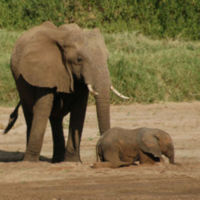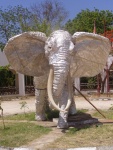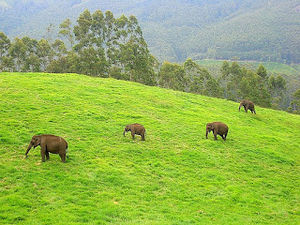Elephant
 From Conservapedia
From Conservapedia | Elephant | |
|---|---|

| |
| African elephant Loxodonta africana | |
| Scientific classification | |
| Kingdom Information | |
| Domain | Eukaryota |
| Kingdom | Animalia |
| Subkingdom | Bilateria |
| Phylum Information | |
| Phylum | Chordata |
| Sub-phylum | Vertebrata |
| Infraphylum | Gnathostomata |
| Class Information | |
| Superclass | Tetrapoda |
| Class | Mammalia |
| Sub-class | Theria |
| Infra-class | Eutheria |
| Order Information | |
| Order | Proboscidea |
| Family Information | |
| Superfamily | Elephantoidea |
| Family | Elephantidae |
| Genus Information | |
| Genera | Elephas Loxodonta |
| Species Information | |
| Species | E. maximus L. africana |
| Population statistics | |
Elephants are two species of large land mammals belonging to the family Elephantidae, the only extant family belonging to the order Proboscidea. The two elephant species currently recognized by scientists are the African elephant (Loxodonta africana) and the Asian elephant (Elephas maximus). Centuries of hunting elephants for their ivory has reduced the population of these animals. Renewed efforts at stewardship have caused a population increase in Africa over the past nineteen years.[1]
Contents
- 1 Description
- 1.1 Species
- 2 Uses of Elephants
- 3 Similar and related species
- 4 Trivia
- 5 Elephant pictures
- 6 See also
- 7 References
Description[edit]
Elephants are the largest land animals alive today. The largest elephant ever recorded (the Fenykovi elephant, now in the Smithsonian Institution) was a male shot in Angola in 1955; it weighed about 10.7 tonnes (12 U.S. tons) and stood 13 feet, 2 inches at the shoulder.[2][3] The slightly-smaller Asian elephant had a maximum recorded height of 11 feet 9 inches and eight tons in one individual recorded in 1985. Forest elephant bulls rarely exceeding eight feet in height.
Apart from their massive size their most striking features are a long trunk, or proboscis, a flexible nose strong enough to lift heavy objects. Their skin is up to 1.5 inches thick and gray in color, with the skin of African bush elephants more heavily wrinkled than their Asian counterparts. All three species possess ivory tusks, but they are generally lacking in female Asian elephants unless rudimentary in size, and even then are only seen when the mouth is open. The legs are columnar and massive; the feet are broad and round.
The African species differs from Asian elephants in the overall shape of the back; it is "saddle-shaped', i.e. the back is concave in the center, while the Asian species has a distinctive hump or arch. African elephants also have larger, fan-shaped ears extending over, and nearly completely-covering, the neck; Asian elephant ears are much smaller. There are two finger-like processes at the tip of the trunk in the African species, while Asian elephants bear one. While both species bear five toes on the forefeet, the African elephant bears three toes on the hind feet; the Asian species has four, and sometimes five, toes on the hind feet.
Species[edit]
African elephants are represented by two subspecies:[4]
- Bush, or savannah elephant (Loxodonta africana africana), of the savannahs and grasslands of sub-Saharan Africa;
- Forest elephant (Loxodonta africana cyclotis), of the tropical rain forests in central Africa.
Some authorities consider both animals to be distinct species, with the extinct North African elephant (Loxodonta africana pharaoensis) a subspecies of the bush elephant.
The Asian elephant has three subspecies:
- Indian elephant (Elephas maximus indicus), of southern and south-eastern Asia;
- Sri Lankan elephant (Elephas maximus maximus), of the island of Sri Lanka in the Indian Ocean;
- Sumatran elephant (Elephas maximus sumatranus), of the islands of Sumatra and Borneo in Indonesia.
Bull elephants, when inclined to mate, enter a frenzied state called musth; they fight with each other for possession of the cow elephants, and become a menace to everything in their path; many humans are killed at this time. Elephants' gestation period, at 22 months, is the longest of any land mammal. At birth it is common for an elephant calf to weigh 120 kg (265 lb). An elephant may live as long as 70 years, sometimes longer.
Uses of Elephants[edit]

Elephants (today generally Indian, but historically African elephants also) have been used as beasts of burden and draught animals, as mounts in processions and in war (notably by Hannibal), playing polo, and as circus performers. They are also popular for tourist rides in Thailand. Elephants are often hunted for the ivory in their tusks.
[edit]
From a molecular and morphological point of view, hyraxes and Sirenians (sea cows and manatees) are the most similar living creatures to elephants,[5] and these groups are hypothesized by evolutionists to have shared a common ancestor approximately 50 million years ago. Creationists say that each kind was separately created, and that two of the elephant kind were on board Noah's Ark, and from these all elephants alive today are descended.
The three extant species of elephant are sole survivors of a much more diverse Proboscidian fauna with some 170 described fossil species and including species of mammoth from North America and the massive Deinotherium, the second largest land mammal that ever lived, which sported two downward facing tusks. According to Young Earth Creationists, some extinct elephants may represent species that did not survive the Great Flood, while some other more recently extinct species represent descendents of the two on board Noah's Ark. Regardless, extinct and living elephants represent a distinct holobaramin separate from other mammals.
Trivia[edit]
- A white elephant (from the historical veneration of such animals in Southeast Asia) is the term for a possession whose initial and upkeep cost exceeds its use (in most cases income), making it an overall liability.
- An elephant is the symbol of America's Republican Party.
- Elephants are the only mammals that can't jump.
Elephant pictures[edit]

See also[edit]
- Elephant in the living room
References[edit]
- ↑ IUCN African Elephant Specialist Group (2013). "2012 continental totals". 2013 Provisional African Elephant Status Report. Retrieved from Elephant Database on October 17, 2014.
- ↑ http://siarchives.si.edu/history/exhibits/thisday/march.htm
- ↑ http://www.cardcow.com/151863/african-bush-elephant-animals-elephants/
- ↑ http://worldwildlife.org/species/african-elephant
- ↑ Hidenori Nishihara et al. A Retroposon Analysis of Afrotherian Phylogeny. Molecular Biology and Evolution 22: 1823-1833,
Categories: [Mammals] [Proboscidea]
↧ Download as ZWI file | Last modified: 02/21/2023 12:50:56 | 93 views
☰ Source: https://www.conservapedia.com/Elephant | License: CC BY-SA 3.0
 ZWI signed:
ZWI signed: KSF
KSF